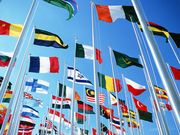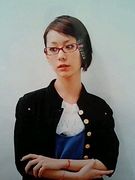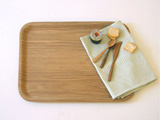問題群(1)(10:00〜11:00)
(1) 日本人は朝食に何を食べるか。
What do Japanese people eat for breakfast?
Generally, Japanese eat either a traditional Japanese breakfast or a western breakfast. The traditional breakfast is boiled rice, dried fish, seaweed, miso soup, and pickles. Also, some people really like natto for breakfast. Natto is fermented soybeans, which is regarded as a health food. The Western breakfast consists of toast, bread, cereal, eggs, ham, bacon, fruit juice, coffee and such.
(2) 日本に鉄砲が伝来したのはいつか。
When were guns or firearms brought to Japan?
It was in 1543 when a Portuguese ship landed on the island of Tanegashima just south of Kyushu. That was the first contact between Europeans and Japanese. The Japanese first learned about firearms and gunpowder from the Portuguese sailors who were on the ship.
(3) 日本人はお正月休みをどう過ごすのか。
What do Japanese people do during the New Year holidays?
On New Year’s Day family members say “Happy New Year” to each other and wish for their good health and happiness. They drink otoso, a kind of rice wine with spices thought to promote longevity; and eat rice cake soup (ozoni) and other New Year’s food called osechi ryori. Also, most Japanese visit shinto shrines or Buddhist temples to pray for good health and success for the year.
(4) 日本では最近はどんな産業が盛んか。
What industries are successful these days in Japan?
Japan’s successful industries include manufacturers of technologically advanced products such as automobiles, electronic equipment, computers, and semiconductors; as well as manufacturers of iron and steel. One more major industry that is also popular is the distinctively Japanese anime and comics industry.
(5) 私のホテルは日比谷にある。成田空港から行くのに一番良い方法は何か。
My hotel is in Hibiya. What is the best way to get there from Narita Airport?
I would recommend the Airport Limousine Bus that goes nonstop from Narita Airport to eight major hotels in the Hibiya area. You can check-in your heavy luggage on the bus. You can buy a ticket at the ticket counter in the arrival lobby and catch the bus just outside the terminal. It generally costs around 3,000 yen per adult for one-way.
(6)〔日本語での質問〕
あなたはどのような通訳ガイドになりたいか。
通訳ガイドになったら心がけたいことは何か。
問題群(2)(11:00〜12:00)
(1) 日本の主要な米作地域はどこか。
What are the major areas for rice cultivation in Japan?
The Tohoku and Hokuriku regions of Honshu are famous for rice cultivation. Among these areas, the most famous rice-producing area is Niigata Prefecture. The most famous rice variety is Koshihikari, which is produced in many areas in Japan, but the tastiest Koshihikari is said to be the one produced in the Uonuma region in Niigata Prefecture.
(2) 江戸時代はどんな時代だったのか。
What was the Edo period like?
The Edo period lasted about 260 years, from 1603 to 1867. During the Edo period, there was a caste system known as “shi-no-ko-sho” (warrior-farmer-artisan-merchant), which placed the warrior class at the top, followed by the farmers, artisans, and merchants. The government established a policy of national isolation and prohibited Christianity. Due to the relative peace and isolation from foreign influence during the Edo Period, many unique Japanese forms of culture developed such as kabuki, ukiyoe wood-block prints, and bunraku.
(3) 日本のどんなファーストフードがお勧めか。
What Japanese fast food do you recommend?
I would recommend tachigui-soba, which is Japanese fast-food soba or udon noodles served at stands located mainly in and around train stations. Tachigui-soba is the equivalent of hotdog or hamburger stands in the West. Customers can order a variety of toppings, from raw eggs to deep-fried vegetables, to add something extra to the noodles. Often customers eat while standing.
(4) なぜ京都が多くの観光客に人気があるのか教えてほしい。
Would you tell me why Kyoto attracts so many tourists?
Kyoto was the capital of Japan and home of the Emperor for over 1,000 years. The city is full of tourist attractions, of which many are designated World Heritage Sites. Over the centuries, Kyoto suffered destruction due to many wars and fires. However, because of its historic value, the city was dropped from the list of target cities for the atomic bomb and spared from air raids during World War II. As a result, countless old temples, shrines and other historically priceless structures remain preserved in the city today.
(5) なぜ日本にとって観光が重要なのか。
Why is tourism so important for Japan?
Tourism is important because it is a means to promote economic growth and also encourage cultural understanding and exchange. Currently, the Japanese economy is now in recession, so it is important for the Japanese government to attract more foreign tourists to Japan, as international tourism is a good source of income and a way for Japan to build better relationships with other peoples.
(6) 日本人は大晦日をふつうはどう過ごすか。
What do Japanese people usually do on New Year’s Eve?
New Year’s Eve is an important day for wrapping up the old and preparing for the new. Japanese make New Year’s food called osechi ryori and clean their houses. In the evening, families generally eat dinner together, watch traditional New Year’s Eve TV programs, and stay up late to listen to the temple bells, which are rung 108 times around midnight. Nowadays, many younger people go to countdown events. After midnight, some people make their first visit of the New Year to shrines or temples.
(7)〔日本語での質問〕
あなたはどのような通訳ガイドになりたいか。
通訳ガイドになったら心がけたいことは何か。
問題群(3)(13:00〜14:00)
(1) 京都の世界遺産について教えてほしい。
Could you tell me about World Heritage sites in Kyoto?
Kyoto was the capital of Japan for more than 1,000 years after 794. Thirteen temples, three shrines and the Nijo Castle are all registered as World Heritage Sites. The most memorable for visiting is "Kinkaku-ji" or Golden Pavilion, originally constructed in 1224. Its stunning image embossed with gold leaf and reflected in the pond is indescribable. The famous novel "Kinkaku-ji" by Yukio Mishima is based on the incident in 1950 when a young monk, obsessed by the temple's beauty, set fire to it and burnt it down.
(2) 日本の茶の湯(お茶席)について教えてほしい。
Please tell me about the tea ceremony in Japan.
Cha-no-yu, or the tea ceremony is the art of serving powdered green tea called matcha. The powdered tea is put into a teacup, hot water is poured on it, it is whipped with a bamboo whisk till it foams and it is drunk. The tea ceremony originated in Zen Buddhist monasteries around the 13th century. Today it is regarded as a way to achieve mental composure and develop elegant manners.
(3) 日本の現在の経済状況についてどう思うか。
What do you think about the current economic situation in Japan?
These days the Japanese economy is very bad. In Japan, both consumer spending and capital investment have been weak for a long time. I hope that the Japanese government will strive hard to boost domestic demand by cutting waste in the government spending and implementing drastic, practical measures.
(4) 日本の梅雨について教えてほしい。
Please tell me about the rainy season in Japan.
Tsuyu is the early summer rainy season. In Honshu it begins about the middle of June and lasts about a month. During the rainy season, the weather is hot, humid, and very uncomfortable. This rain is, however, needed by the farmers. After the rainy season begins, rice seedlings are transplanted from nurseries to rice paddies.
(5) 忘年会とは何か。
What is bonenkai?
Bonenkai literally means "forget-the-past-year party." Bonenkai are held at the end of the year in December, so that people can get together, eat and drink, and forget the year’s hard work and unpleasant memories. It is commonly believed that the parties are necessary to maintain good relations at work. Roughly half of men think the parties are social events related to work. However, the number of parties attended differs between men and women. Most men attend at least two Bonenkai, while most women normally do not attend as many as men do.
(6) レストランのショーケースでプラスティックの食品模型を見かけた。あれは何か。
I saw plastic food samples in the showcase of a restaurant. What are they? They are plastic samples of food made to look almost exactly like the food served in the restaurant. Instead of putting pictures of food in a menu, restaurants display an array of plastic food samples with a price tag and the name of the food. People can see what the meals are going to look like and also see the prices before deciding whether to enter the restaurant.
(7)〔日本語での質問〕
あなたはどのような通訳ガイドになりたいか。
通訳ガイドになったら心がけたいことは何か。
(1) 日本人は朝食に何を食べるか。
What do Japanese people eat for breakfast?
Generally, Japanese eat either a traditional Japanese breakfast or a western breakfast. The traditional breakfast is boiled rice, dried fish, seaweed, miso soup, and pickles. Also, some people really like natto for breakfast. Natto is fermented soybeans, which is regarded as a health food. The Western breakfast consists of toast, bread, cereal, eggs, ham, bacon, fruit juice, coffee and such.
(2) 日本に鉄砲が伝来したのはいつか。
When were guns or firearms brought to Japan?
It was in 1543 when a Portuguese ship landed on the island of Tanegashima just south of Kyushu. That was the first contact between Europeans and Japanese. The Japanese first learned about firearms and gunpowder from the Portuguese sailors who were on the ship.
(3) 日本人はお正月休みをどう過ごすのか。
What do Japanese people do during the New Year holidays?
On New Year’s Day family members say “Happy New Year” to each other and wish for their good health and happiness. They drink otoso, a kind of rice wine with spices thought to promote longevity; and eat rice cake soup (ozoni) and other New Year’s food called osechi ryori. Also, most Japanese visit shinto shrines or Buddhist temples to pray for good health and success for the year.
(4) 日本では最近はどんな産業が盛んか。
What industries are successful these days in Japan?
Japan’s successful industries include manufacturers of technologically advanced products such as automobiles, electronic equipment, computers, and semiconductors; as well as manufacturers of iron and steel. One more major industry that is also popular is the distinctively Japanese anime and comics industry.
(5) 私のホテルは日比谷にある。成田空港から行くのに一番良い方法は何か。
My hotel is in Hibiya. What is the best way to get there from Narita Airport?
I would recommend the Airport Limousine Bus that goes nonstop from Narita Airport to eight major hotels in the Hibiya area. You can check-in your heavy luggage on the bus. You can buy a ticket at the ticket counter in the arrival lobby and catch the bus just outside the terminal. It generally costs around 3,000 yen per adult for one-way.
(6)〔日本語での質問〕
あなたはどのような通訳ガイドになりたいか。
通訳ガイドになったら心がけたいことは何か。
問題群(2)(11:00〜12:00)
(1) 日本の主要な米作地域はどこか。
What are the major areas for rice cultivation in Japan?
The Tohoku and Hokuriku regions of Honshu are famous for rice cultivation. Among these areas, the most famous rice-producing area is Niigata Prefecture. The most famous rice variety is Koshihikari, which is produced in many areas in Japan, but the tastiest Koshihikari is said to be the one produced in the Uonuma region in Niigata Prefecture.
(2) 江戸時代はどんな時代だったのか。
What was the Edo period like?
The Edo period lasted about 260 years, from 1603 to 1867. During the Edo period, there was a caste system known as “shi-no-ko-sho” (warrior-farmer-artisan-merchant), which placed the warrior class at the top, followed by the farmers, artisans, and merchants. The government established a policy of national isolation and prohibited Christianity. Due to the relative peace and isolation from foreign influence during the Edo Period, many unique Japanese forms of culture developed such as kabuki, ukiyoe wood-block prints, and bunraku.
(3) 日本のどんなファーストフードがお勧めか。
What Japanese fast food do you recommend?
I would recommend tachigui-soba, which is Japanese fast-food soba or udon noodles served at stands located mainly in and around train stations. Tachigui-soba is the equivalent of hotdog or hamburger stands in the West. Customers can order a variety of toppings, from raw eggs to deep-fried vegetables, to add something extra to the noodles. Often customers eat while standing.
(4) なぜ京都が多くの観光客に人気があるのか教えてほしい。
Would you tell me why Kyoto attracts so many tourists?
Kyoto was the capital of Japan and home of the Emperor for over 1,000 years. The city is full of tourist attractions, of which many are designated World Heritage Sites. Over the centuries, Kyoto suffered destruction due to many wars and fires. However, because of its historic value, the city was dropped from the list of target cities for the atomic bomb and spared from air raids during World War II. As a result, countless old temples, shrines and other historically priceless structures remain preserved in the city today.
(5) なぜ日本にとって観光が重要なのか。
Why is tourism so important for Japan?
Tourism is important because it is a means to promote economic growth and also encourage cultural understanding and exchange. Currently, the Japanese economy is now in recession, so it is important for the Japanese government to attract more foreign tourists to Japan, as international tourism is a good source of income and a way for Japan to build better relationships with other peoples.
(6) 日本人は大晦日をふつうはどう過ごすか。
What do Japanese people usually do on New Year’s Eve?
New Year’s Eve is an important day for wrapping up the old and preparing for the new. Japanese make New Year’s food called osechi ryori and clean their houses. In the evening, families generally eat dinner together, watch traditional New Year’s Eve TV programs, and stay up late to listen to the temple bells, which are rung 108 times around midnight. Nowadays, many younger people go to countdown events. After midnight, some people make their first visit of the New Year to shrines or temples.
(7)〔日本語での質問〕
あなたはどのような通訳ガイドになりたいか。
通訳ガイドになったら心がけたいことは何か。
問題群(3)(13:00〜14:00)
(1) 京都の世界遺産について教えてほしい。
Could you tell me about World Heritage sites in Kyoto?
Kyoto was the capital of Japan for more than 1,000 years after 794. Thirteen temples, three shrines and the Nijo Castle are all registered as World Heritage Sites. The most memorable for visiting is "Kinkaku-ji" or Golden Pavilion, originally constructed in 1224. Its stunning image embossed with gold leaf and reflected in the pond is indescribable. The famous novel "Kinkaku-ji" by Yukio Mishima is based on the incident in 1950 when a young monk, obsessed by the temple's beauty, set fire to it and burnt it down.
(2) 日本の茶の湯(お茶席)について教えてほしい。
Please tell me about the tea ceremony in Japan.
Cha-no-yu, or the tea ceremony is the art of serving powdered green tea called matcha. The powdered tea is put into a teacup, hot water is poured on it, it is whipped with a bamboo whisk till it foams and it is drunk. The tea ceremony originated in Zen Buddhist monasteries around the 13th century. Today it is regarded as a way to achieve mental composure and develop elegant manners.
(3) 日本の現在の経済状況についてどう思うか。
What do you think about the current economic situation in Japan?
These days the Japanese economy is very bad. In Japan, both consumer spending and capital investment have been weak for a long time. I hope that the Japanese government will strive hard to boost domestic demand by cutting waste in the government spending and implementing drastic, practical measures.
(4) 日本の梅雨について教えてほしい。
Please tell me about the rainy season in Japan.
Tsuyu is the early summer rainy season. In Honshu it begins about the middle of June and lasts about a month. During the rainy season, the weather is hot, humid, and very uncomfortable. This rain is, however, needed by the farmers. After the rainy season begins, rice seedlings are transplanted from nurseries to rice paddies.
(5) 忘年会とは何か。
What is bonenkai?
Bonenkai literally means "forget-the-past-year party." Bonenkai are held at the end of the year in December, so that people can get together, eat and drink, and forget the year’s hard work and unpleasant memories. It is commonly believed that the parties are necessary to maintain good relations at work. Roughly half of men think the parties are social events related to work. However, the number of parties attended differs between men and women. Most men attend at least two Bonenkai, while most women normally do not attend as many as men do.
(6) レストランのショーケースでプラスティックの食品模型を見かけた。あれは何か。
I saw plastic food samples in the showcase of a restaurant. What are they? They are plastic samples of food made to look almost exactly like the food served in the restaurant. Instead of putting pictures of food in a menu, restaurants display an array of plastic food samples with a price tag and the name of the food. People can see what the meals are going to look like and also see the prices before deciding whether to enter the restaurant.
(7)〔日本語での質問〕
あなたはどのような通訳ガイドになりたいか。
通訳ガイドになったら心がけたいことは何か。
|
|
|
|
|
|
|
|
翻訳通訳の仕事をしたい人はココ 更新情報
-
最新のアンケート
翻訳通訳の仕事をしたい人はココのメンバーはこんなコミュニティにも参加しています
人気コミュニティランキング
- 1位
- お洒落な女の子が好き
- 90013人
- 2位
- 写真を撮るのが好き
- 208279人
- 3位
- 暮らしを楽しむ
- 75470人
























